

Posted on 05/11/2006 3:04:49 PM PDT by Republicanprofessor
It is definitely time to finish my series of art “lectures.” So today I want to explore Neoclassicism, from about 1780, to Romanticism in the 1830s and 1840s. The style just before Neoclassicism was the fluffy Rococo style. This in turn was a reaction to the heavy style of the Baroque, especially under the absolute monarch Louis XIV, whose home was in that little “hunting lodge” of Versailles. In contrast to King Louis’s massive weight, in body and in taste, we have the lighter “fluffier” forms of the Rococo.


My favorite is The Swing, on the right, by Fragonnard. What’s that man doing in the lower left? Looking up a lady’s skirt?! (Has anything changed in 270 years?) What is also interesting is the oblivious priest who pushes her swing. The foliage is more like the down from pillows than it is like real trees. Nothing is “realistic” and it appears almost like a dream. Love themes predominated in this period (shown well in movies like Valmont and Dangerous Liaisons)
The Neoclassical period, beginning about 1787, reacts against such frivolity. But let us first look at the inspiration for Jacques Louis David (1748-1825) in the work of the Baroque Neoclassicist Nicolas Poussin. In such works as In Arcadio Ego 1655 and St. John on Patmos Island, Poussin revived the Greco-Roman themes of morality with a perfection of realism. Note how the toga-attired shepherds are pondering the presence of a sarcophagus in the middle of perfect Arcadia. See how the poses echo each other and yet are reversed: standing figure ahead on the right and behind on the left? He thus creates an asymmetrical balance with just a bit of variety and movement that will be seen later (and updated with brighter color) in the work of Cezanne. (For more information on Cezanne, a very difficult artist to understand, see class 3: Cezanne and van Gogh; http://www.freerepublic.com/focus/f-chat/1419876/posts)


Now, a century after Poussin and the intermission of the lighter Rococo style, David returns to what we call a Poussiniste style in paintings such as Oath of the Horatii in 1784. All the light and fluffy aristocratic love themes are erased with a return to Greco-Roman morality and heroism.


In the left work, Oath of the Horatii from 1784, three Horatii brothers are getting ready to fight three opposing brothers, the Curatii. They create muscular, masculine angles as they swear to their father that they will fight to the death. On the other side, the rounded women are weak and upset because they will lose either a brother or a husband (one is a sister of the Horatii who is married to one of the opponents; the other is a Curatia sister married to a Horatio brother). The outcome? One of the Horatio brothers survives the battle and wins. When he meets his sister outside the city gates, he doesn’t embrace her; instead he runs his sword through her because she was not loyal to their cause. The uncompromising morality in this work becomes a rallying cry for the French Revolution.
The Death of Socrates from 1787 is much the same: note the strongly outlined forms in classical togas and the rather dull color. Also note the muscular anatomy of Socrates at age 70; he is about to drink the poisoned hemlock and to die as decided by a Greek jury. His pose resembles that of Christ, complete with disciples gathered around him. Plato, seated at the end of the bed, bows his head with grief. His family is ushered out in the dull gray background. (Some in contemporary criticism have noted that the muscular disciple in red with the hemlock was a lover of Socrates….but we don’t have to go there.)
Some art historians have said that these paintings mark the end of traditional realism in painting, that the space no longer recedes indefinitely in perfect perspective (as in the work of Raphael and the School of Athens).

Yes, David's space is accurately rendered, but the gray background in both works is like a shallow frieze in a low sculptural relief; the figures pop out at us instead of having the background recede away forever. This use of figures thrusting forward is only more enhanced in twentieth century modernism.
After David’s death, Ingres became the preeminent neoclassical painter. (Note that David is pronounced Da VEED and Ingres pronounced very strangely; all vowels.) At first, the academy did not think a great deal of Ingres’ work. See how distorted the lower back is in the one on the left? David has added a few extra vertibrae; I think that the lower part of the back was his favorite part of a woman, and thus he so exaggerated it. That painting is called the Grand Odalisque. But when the Academy artists saw Delacroix’s work, they realized how neoclassical Ingres was in comparison and supported him as David's successor.

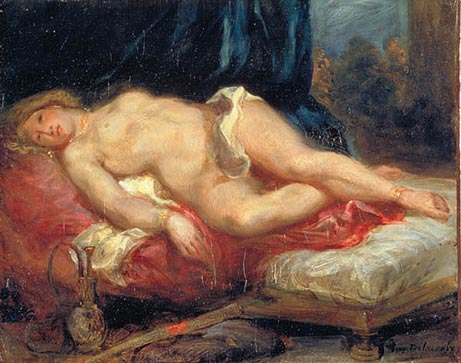
Ingres Grand Odalisque from the Louvre and Delacroix’s smaller Odalisque
First I should mention what an odalisque is: a woman of the middle eastern harems. She was not quite a prostitute but she was obliged to answer the needs of her master (and his friends). Now, this as a subject itself is more romantic than neoclassical, and Ingres’ deep and rich use of blue is not the dull, controlled color of David or Poussin. And yet Ingres himself did not realize what romantic tendencies he had in his work. And he succeeded in keeping his rival Delacroix out of the Academy for many years.
Delacroix’s Odalisque above is very different from that of Ingres. Can you think of a story, re the master and his relationship with his “ladies”? I see the Ingres as a pre-sexual encounter and the Delacroix as afterwards. Do you see suggestions of wild activity, violence, or perhaps even rape in the bloody red colors that Delacroix chooses? His brushstrokes are also much more blurred and emotional: showing all the qualities of Romanticism. Delacroix and his romantic colleagues were called the Rubenistes (as opposed to Ingres and David the Poussinistes). Delacroix's work was supposed to echo the looser, more painterly colors of Rubens--below--(even if his figures did not have Rubenesque bulk).

Romanticism in the early to mid-nineteenth century does not mean the valentines, roses and chocolates of today. Instead, it is derived from the Gothic “romance” novels of the time: with mystery, violence, death, and scandal. It is dramatic, moving, and everything that the preceding, controlled neoclassicism repudiated.


Two other notable Delacroix paintings are those above: The Death of Sardanapolous above and Liberty Leading the People below. Delacroix painted that sensuous nude in the first painting as a prerequisite to get into the Salon, but it didn’t work at that time. That painting is based on a poem by the romantic poet Lord Byron on the Assyrian king who, rather than be taken alive by the barbarians storming his gates, brought all of value into his chamber to have them destroyed before he himself set fire to the palace and died. This is a most romantic theme: full of the violence, tension of life and death, fiery reds, etc. (As an aside, the relationship between romantic poetry, music, and art is all very strong at this time: think of the dramatic late works by Beethoven, the poetry of Coleridge, etc. But that is another “lecture” in itself.)
By the way, the half-nude lady in the second painting is an allegory of Liberty. This reflects not the French Revolution of 1789 but a different revolution of 1830. (French nineteenth century history alternates frequently between empires and republican revolutions and their governments and is always quite confusing to me.)

One other dramatic work that I have to mention is Gerricault’s Raft of the Medusa, above. This was a major political scandal from the foundering of a ship, called the Medusa, en route from Algeria to France with Algerian immigrants. When the ship was sinking, the incompetent captain and crew claimed all the life boats. 150 people then climbed aboard the life raft seen here; after 10 days at sea (and cannibalism), only 15 survived. Here we see a father mourning his dead son, amidst other dead bodies, as a pyramid grows with struggling figures supports a figure who waves to a rescuing ship. This was a huge painting that, hung at eye level, made the disaster come alive to the viewing audience.
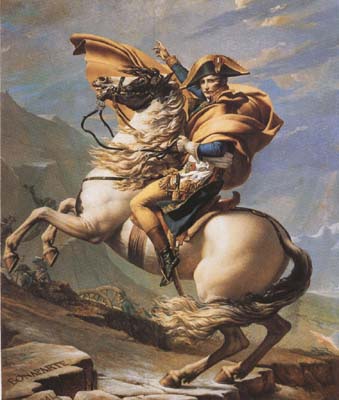

Another great neoclassical vs. romantic comparison is that of David’s Napoleon Crossing the Alps vs. Gerricault’s Mounted Officer. Notice how much more exaggerated and emotional the Gerricault is. I love the way the horse is rearing on tip-hoof, an impossible but highly dramatic pose. In regard to the David, note the names of Hannibal and other who also crossed the Alps for battle (barely legible in the lower left corner beneath Bonaparte).
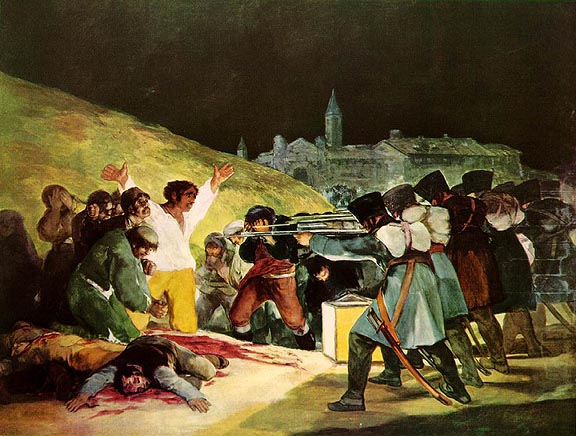
In Spain, Romanticism is best seen in the work of Goya, who, like Beethoven, went deaf shortly after 1800. He was able to conjure up the deepest ghouls and deathly visions from within himself that still can shock us today. His most famous painting is probably Third of May 1808 from 1814. Here we have Napoleon’s army executing those who rebelled the day before in Madrid. The angular machine-like soldiers on the right recall David’s Horatii above. The victims react in different ways: one man cries, the man in the center faces the squad with great bravery, his pose reflecting the crucifixion of Christ. A priest gives the last rites before he himself is killed. This violent death is very romantic: with all the blurred edges, bright color and dramatic contrasts of light and dark that we expect.


Goya was also a master of etchings, from his Disasters of War or Caprichos series.
In Germany, Friedrich was the master of romantic landscapes. His desolate graveyards, ruined cathedrals, barren winter branches, and spectacular, death-foreshadowing sunsets are still evocative today. In fact, if you crop the sunset, can you see Rothko? (For more on a recent thread on Rothko, check out http://www.freerepublic.com/focus/f-news/1628522/posts)



Finally, in England, we have two romantic artists. Constable is more of a romantic naturalist, but his evocative images of Sussex are always nostalgic and laden with his own life experience there.



Constable was one the first to use bright green to depict grass, seen best in Wivenhoe Park above with the cows. If you noticed in the early Poussin images at the beginning of this post, the trees tended to be rather brown. But Constable made studies outside (not in the studio), so he recreated the bright greens. In one anecdote, he confronted the complaining critics by putting a violin (the color of previous landscape paintings) on a green lawn and asked what color the lawn truly was. In addition, his specks of paint (to create the sense of light on foliage) was derided as “snow” by critics, but his painterly style influenced artists from Delacroix to Monet. He was also a master of clouds, writing the date, wind speed, and weather on the backs of his works.
Romantic as he was, Constable still looks tame compared to Turner. Turner’s early works were so realistic that one could almost recreate the rigging on his distant ships. But even in the early works one could see how it was really the sun, and its reflections, that most interested Turner.

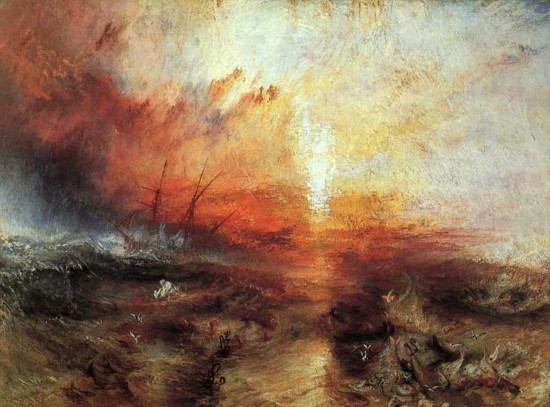
In Turner’s Slave Ship c. 1839 we see a disaster at sea. This is all the more tragic because the owner was insured against loss at sea but not against sickness and death, so the ill slaves are tossed overboard. (This piece sickens me each time I discuss it. See the parts of bodies in the right foreground?) However, the captain gets what’s coming to him, for he is sailing into a tornado and will also be killed. How is this work romantic? The fiery sea dissolves into the sky without any firm separation; there is a painterly blur of bright colors, and a dramatic scene. (There is no way to recreate these colors from the internet or in traditional photos. One must simply see the work at the Museum of Fine Arts in Boston to truly appreciate it. It glows with passion.)
A few stories about Turner: if he was on a train in a storm, he would stick his head out of the window to feel the effects of the wind and rain in his face. Or he would have himself tied to the mast of a ship in a storm to feel the effects of wind, sea, steam, fire, etc. There are very few solid forms in his later works. Some of his sunset and sunrise paintings are almost totally dissolved of form. Again, does this remind you of Rothko, but one hundred years before the Abstract Expressionists?


Turner Sunrise Norham Castle c. 1845 and Rothko from the 1950s
It is not perhaps an illogical link between the Romantics and the Abstract Expressionists. Both groups were interested in exploring ranges of emotion through blurred, painterly color and dramatic contrasts of light and dark. The Romantics were the first to break free of the constraints of neoclassical control and the rules of art for centuries past. Perhaps we could think of the Abstract Expressionists as the last, and most extreme, result of that break over a century earlier.
Wonderful, and so informative - thanks! I especially liked the Friedrich with the two small figures in black.
Deep thanks....
Not creepy ENOUGH for that goofy pair.

I worked at the MFA in Boston during the Renoir exhibit ('86-'87) and have had enough Renoir to last me a lifetime. I was blessed a few years earlier to catch the only exhibit of Bouguereau in this country at the Wadsworth Atheneum and have been a fan ever since.
IF you say so! < g >
I think Goethe posited that all art goes through three natural stages: classic, romantic and decadent and moves on to another form of classic that starts the process all over again, ever run across this?
I prefer the Cezane to the first Poussin. Due to the more realistic colors its easier to get 'into' the Cezane. I can picture myself walking the trail there to the buildings in the background while the Poussin doesn't draw me in as well.
I like the Davids also. These work over the sofa so to speak. I guess being a fan of the imagery of those eras helps. The broken blocks in the wall in The Death of Socrates make the whole scene real. Minor details are important. I guess that's why I tend more to the realist types of paintings and shun the abstracts and some impressionists
Again in Ingres Grand Odalisque and Delacroix’s Odalisque I greatly prefer the first over the second. Even with the extended version of the lower back Ingres image is of a woman. Delacroix is merely some smears of color on canvas. One thing I will give D credit for though is the smear of color in the right background. Gives the impression of several people back there looking in.
Rubens. Ugly fat chicks. Enough said.
Delacroix's The Death of Sardanapolous The nude in the first is the only redeeming feature I see in this one. But then I tend to like ladies posteriers and this one is shapely and well rendered. The rest of the image is too dark and cluttered for my taste. The nude doesn't really seem to add anything to the picture as the image is overwhelmingly full as it is. It's like "Where's Waldo" in paint.
Liberty Leading the People. Why are her breasts hanging out? doesn't add anything to the image at all. Just serves as a distraction. I think it would have worked far better if she were draped somewhat Romanish (Greekish?). As it is her image is incongruous with the whole and thus detracts from the story. What would be a good battle type painting now leads to the sole question "why is that lady half naked?" It's not even battle damage to her clothes. It's more like she's playing the slut in the middle of a battle. Just doesn't fit.
Raft of the Medusa. Again far too cluttered for my taste. The story behind the painting is cool but how could you tell that from looking at the picture. The father doesn't look like he's mourning. looks more like Rodin's "the thinker" (?)
David’s Napoleon Crossing the Alps vs. Gerricault’s Mounted Officer. David wins hands down. I don't do exageration very well.
Goya. Looks far too cartoonish for my taste. The colors are just strange to me. The central 'victim' is wearing a spotless white shirt and spotless trousers yet he's presumably been imprisoned.
Friedrich. these I like. The first has an almost photographic realism of an obviously not real subject. Like the Cezane earlier it draws me in. Whose being buried there. What's behind the ruined cathedral? I can see myself exploring the area.
Constable. I also like these. While thefirst is somewhat blurred it's light enough to still look real (or at least close enough). I've always liked landscapes though so I'm biased here.
Turner I don't care for. Too blurry (or perhaps too close to monotone?) I can't relate to something that's not there.
Rothko. My five year old daughter colors better than this.
Kind of long I know but it's been a while since I've played. All in all a much better period and style for me.
All the French are political whores, except perhaps Eric Rohmer.
Have you been reading Jasper Fforde's The Eyre Affair?
LOL.....not sure how familiar you are with Ingres...perhaps the ultimate revolutionary/counter revolutionary/counter revolutionary reactionary revolutionist....the guy knew how to kiss butt to save his neck!
I guess I'm going to go along with everyone else on Ingres - even though he is the one academic who really gets recognition, and I tend to like academic work, Ingres is not my favorite. I *really* don't like the Odalisque, much prefer the one by Delacroix, which, while not so tightly rendered has far more of the feeling of reality. I agree with those who prefer the drawings of Ingres to his paintings, for the most part (I tend to think the same of Rubens).
As an aside, even though I rank Velasquez as tops among artists of all eras, I'm not even thrilled with his odalisque-like Venus/mirror figure, though it's a big improvement over the Ingres. Delcroix is best on that.

Weirdly, I do like Fragonard, in spite of the fluffiness. I guess fluff has its place, anyhow they are kind of delighful. Unexpectedly. Perhaps I'm having a reaction to the self importance of modern art.
Fascinating to read that Constable was first to use bright green for grass, I'm wondering if the old painters who preceded him may not have a had a bright yellow, I already know that their access to bright blues was limited.
Turner's one of my favorites, in spite or because of his quite abstract syle! 'Course, the only similarity I see from Turner to Rothko is that both use a horizon line.
RP, wasn't David involved in the French Revolution politically, in an unsavory manner somehow?
I always thought that The Death of Socrates should be titled "Socrates Tells His Last Pun".
It was hard to stay alive during the Revolution(s). Just ask Robespierre.
Professor,
I would love to join your ping list. Think you could add me, or does someone else act as the caretaker for it? Thanks


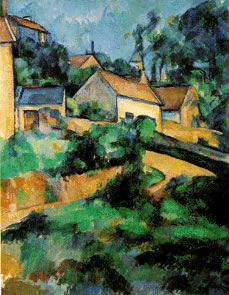

In Delacroix's Odalisque, the image in the back may be the man leaving after doing his "duty;" a kind of wham-baam-thank-you-ma'am, if you will.

In Liberty, the half nude torso is because she is a symbol of Liberty. She is not really there in the battle (well, the whole thing is a bit contrived and symbolic, the telling way that the dead bodies are conveniently posed and all). She is holding the flag and urging those on to battle; symbolically, as I said. This is just a detail, but it focuses on what your interest was.
Thanks for joining the discussion.

I've added you to both ping lists: the regular art ping and the Art Education/Appreciation ping list which is much rarer.
I just posted 2 more articles this morning. If you do a keyword search under Art you will find them and perhaps they'll interest you.
But from now on you are on the ping lists.
Disclaimer: Opinions posted on Free Republic are those of the individual posters and do not necessarily represent the opinion of Free Republic or its management. All materials posted herein are protected by copyright law and the exemption for fair use of copyrighted works.